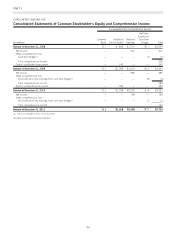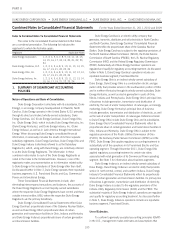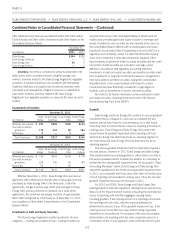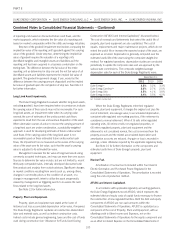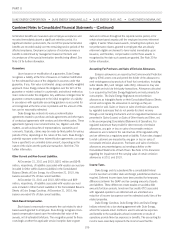Duke Energy 2011 Annual Report Download - page 126
Download and view the complete annual report
Please find page 126 of the 2011 Duke Energy annual report below. You can navigate through the pages in the report by either clicking on the pages listed below, or by using the keyword search tool below to find specific information within the annual report.
PART II
DUKE ENERGY CORPORATION •DUKE ENERGY CAROLINAS, LLC •DUKE ENERGY OHIO, INC. •DUKE ENERGY INDIANA, INC.
Combined Notes to Consolidated Financial Statements – (Continued)
termination benefits are measured upon employee acceptance and
recorded immediately absent a significant retention period. If a
significant retention period exists, the cost of the special termination
benefits are recorded ratably over the remaining service periods of the
affected employees. Employee acceptance of voluntary severance
benefits is determined by management based on the facts and
circumstances of the special termination benefits being offered. See
Note 19 for further information.
Guarantees.
Upon issuance or modification of a guarantee, Duke Energy
recognizes a liability at the time of issuance or material modification
for the estimated fair value of the obligation it assumes under that
guarantee, if any. Fair value is estimated using a probability-weighted
approach. Duke Energy reduces the obligation over the term of the
guarantee or related contract in a systematic and rational method as
risk is reduced under the obligation. Any additional contingent loss for
guarantee contracts subsequent to the initial recognition of a liability
in accordance with applicable accounting guidance is accounted for
and recognized at the time a loss is probable and the amount of the
loss can be reasonably estimated.
Duke Energy has entered into various indemnification
agreements related to purchase and sale agreements and other types
of contractual agreements with vendors and other third parties. These
agreements typically cover environmental, tax, litigation and other
matters, as well as breaches of representations, warranties and
covenants. Typically, claims may be made by third parties for various
periods of time, depending on the nature of the claim. Duke Energy’s
potential exposure under these indemnification agreements can range
from a specified to an unlimited dollar amount, depending on the
nature of the claim and the particular transaction. See Note 7 for
further information.
Other Current and Non-Current Liabilities.
At December 31, 2011 and 2010, $251 million and $248
million, respectively, of liabilities associated with vacation accrued are
included in Other within Current Liabilities in the Consolidated
Balance Sheets of Duke Energy. As of December 31, 2010, this
balance exceeded 5% of total current liabilities.
At December 31, 2011 and 2010, $92 million and $89
million, respectively, of liabilities associated with vacation accrued
were included in Other Current Liabilities in the Consolidated Balance
Sheets of Duke Energy Carolinas. At December 31, 2010, this
balance exceeded 5% of total current liabilities.
Stock-Based Compensation.
Stock-based compensation represents the cost related to stock-
based awards granted to employees. Duke Energy recognizes stock-
based compensation based upon the estimated fair value of the
awards, net of estimated forfeitures. The recognition period for these
costs begin at either the applicable service inception date or grant
date and continues throughout the requisite service period, or for
certain share-based awards until the employee becomes retirement
eligible, if earlier. Share-based awards, including stock options, but
not performance shares, granted to employees that are already
retirement eligible are deemed to have vested immediately upon
issuance, and therefore, compensation cost for those awards is
recognizedbythedatesuchawardsaregranted.SeeNote20for
further information.
Accounting For Purchases and Sales of Emission Allowances.
Emission allowances are issued by the Environmental Protection
Agency (EPA) at zero cost and permit the holder of the allowance to
emit certain gaseous by-products of fossil fuel combustion, including
sulfur dioxide (SO2) and nitrogen oxide (NOx). Allowances may also
be bought and sold via third party transactions. Allowances allocated
to or acquired by the Duke Energy Registrants are held primarily for
consumption. The Duke Energy Registrants record emission
allowances as Intangible Assets on their Consolidated Balance Sheets
at cost and recognize the allowances in earnings as they are
consumed or sold. Gains or losses on sales of emission allowances
by regulated businesses that do not provide for direct recovery
through a cost tracking mechanism and non-regulated businesses are
presented in Gains (Losses) on Sales of Other Assets and Other, net,
in the accompanying Consolidated Statements of Operations. For
regulated businesses that provide for direct recovery of emission
allowances, any gain or loss on sales of recoverable emission
allowances are included in the rate structure of the regulated entity
and are deferred as a regulatory asset or liability. Future rates charged
to retail customers are impacted by any gain or loss on sales of
recoverable emission allowances. Purchases and sales of emission
allowances are presented gross as investing activities on the
Consolidated Statements of Cash Flows. See Note 12 for discussion
regarding the impairment of the carrying value of certain emission
allowances in 2011 and 2010.
Income Taxes.
Duke Energy and its subsidiaries file a consolidated federal
income tax return and other state and foreign jurisdictional returns as
required. Deferred income taxes have been provided for temporary
differences between the GAAP and tax carrying amounts of assets
and liabilities. These differences create taxable or tax-deductible
amounts for future periods. Investment tax credits (ITC) associated
with regulated operations are deferred and are amortized as a
reduction of income tax expense over the estimated useful lives of the
related properties.
Duke Energy Carolinas, Duke Energy Ohio and Duke Energy
Indiana entered into a tax sharing agreement with Duke Energy,
where the separate return method is used to allocate tax expenses
and benefits to the subsidiaries whose investments or results of
operations provide these tax expenses or benefits. The accounting for
income taxes essentially represents the income taxes that the
106





